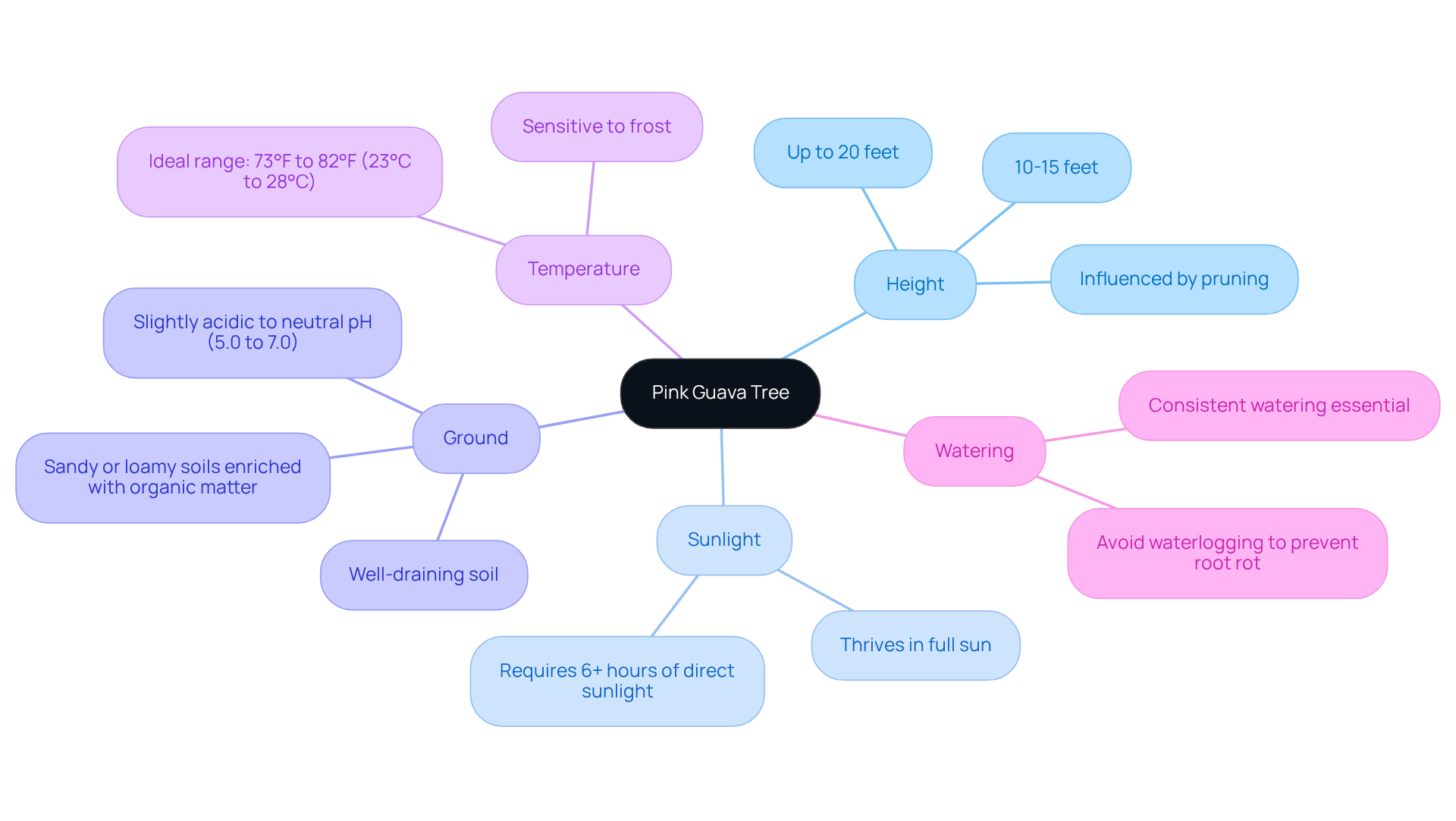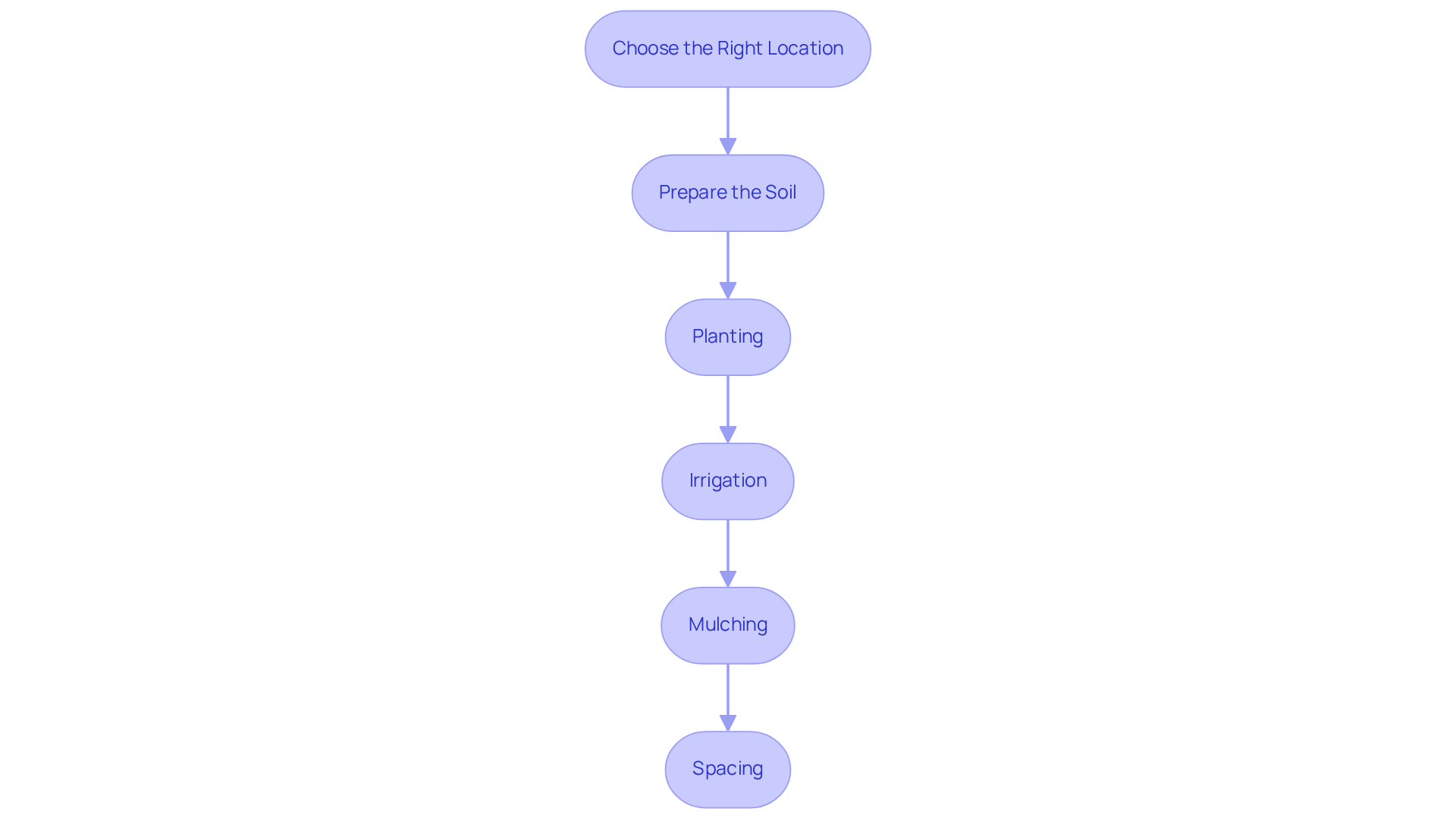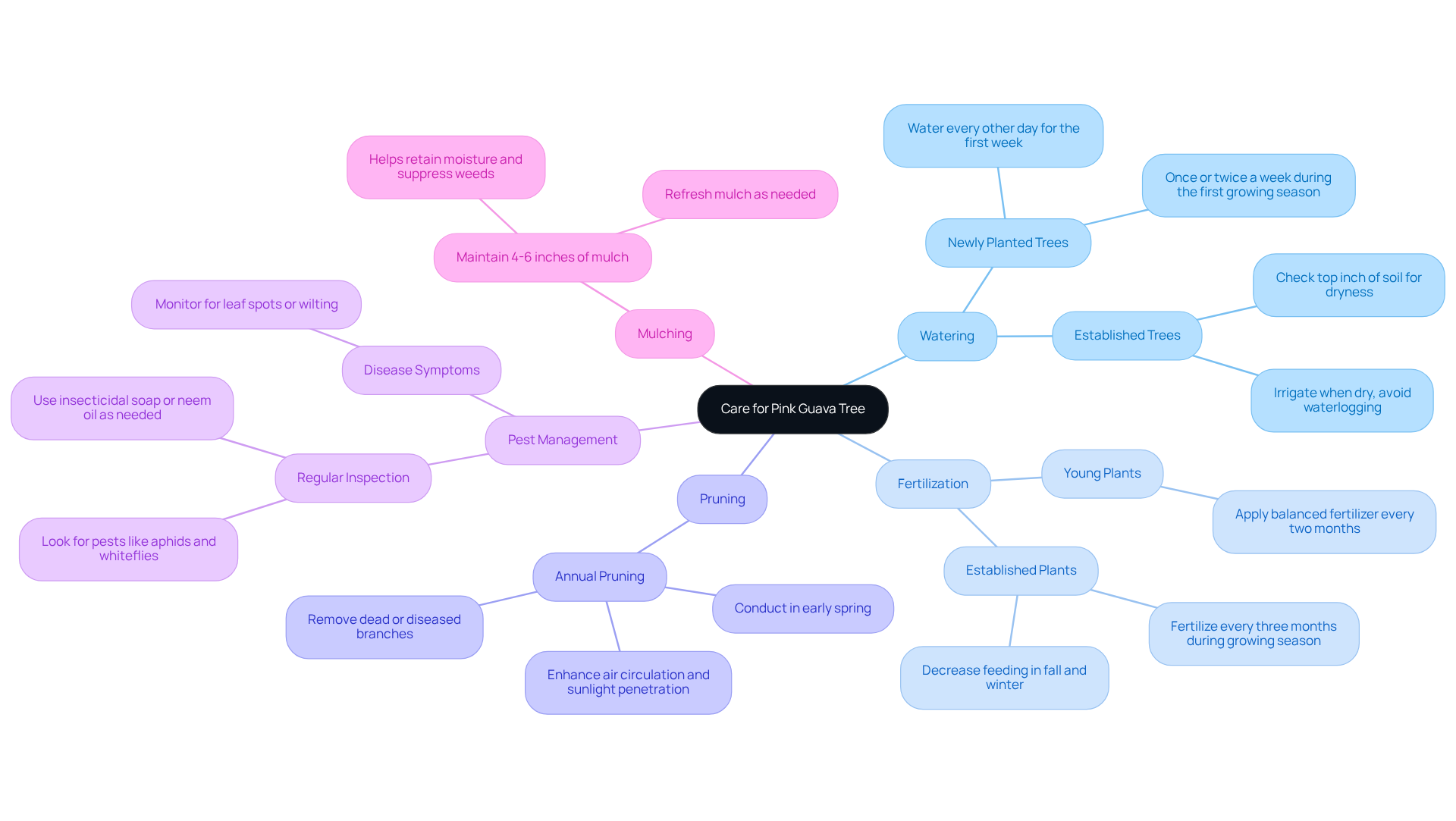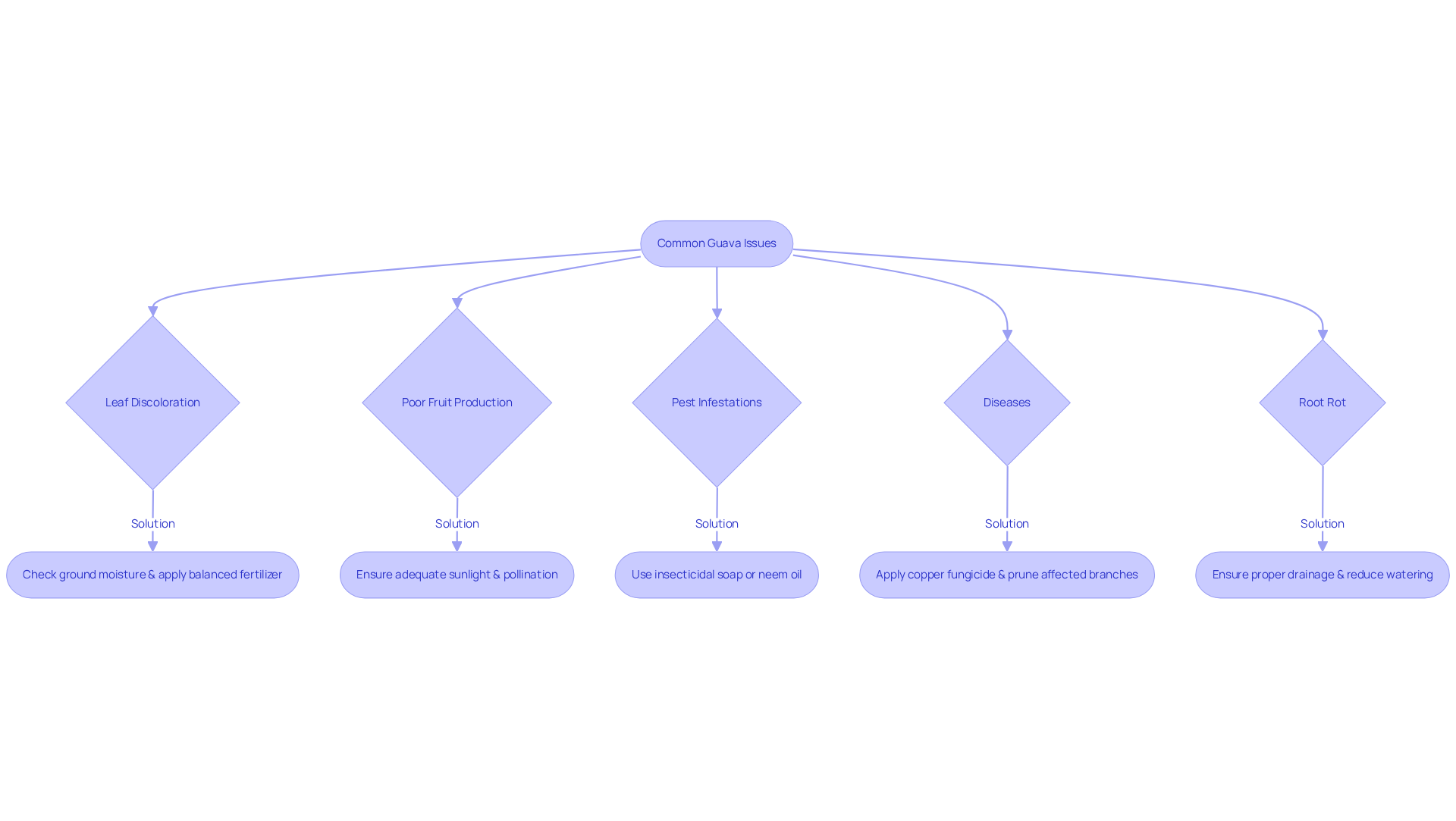
Master the Pink Guava Tree: Essential Steps for Successful Growth
Share
The pink guava tree, known for its vibrant fruit and fragrant leaves, provides not only aesthetic beauty but also a rewarding gardening experience for those who are willing to nurture it. This guide serves as an essential resource for cultivating a thriving pink guava tree, outlining the specific growing conditions required and the necessary care for optimal fruit production.
While the journey to a bountiful harvest is promising, it is important to recognize the common pitfalls that gardeners may encounter, ensuring that their pink guava trees flourish.
Thinking about growing a Pink Guava tree in your garden?
Explore the Barbie Pink Guava Tree at Everglades Farm, shipped directly from Florida.
1. Understand the Pink Guava Tree: Characteristics and Growing Conditions
The rose-colored Psidium (Psidium guajava) is renowned for its sweet, fragrant fruit and appealing leaves. Understanding its key characteristics and optimal growing conditions is essential for successful cultivation:
- Height: Pink Guava trees typically reach heights of 10 to 15 feet, with mature trees potentially growing up to 20 feet, influenced by pruning and care practices.
- Sunlight: These trees flourish in full sun, requiring a minimum of 6+ hours of direct sunlight daily to promote optimal growth and fruiting.
- Ground: A well-draining ground is crucial, ideally with a slightly acidic to neutral pH range of 5.0 to 7.0. Sandy or loamy soils enriched with organic matter provide the best conditions for growth.
- Temperature: The pink guava tree thrives in warm climates, ideally between 73°F to 82°F (23°C to 28°C). They are sensitive to frost, necessitating protection in cooler climates.
- Watering: Consistent watering is essential, particularly during dry spells. However, care must be taken to avoid waterlogging, which can lead to root rot.
Furthermore, the pink guava tree is among the tropical plants that can yield fruit in their first year and flourish in USDA Zones 3-11 for patios and 9-11 outdoors. By understanding these factors, you can create an ideal environment for your fruit plant, ensuring robust growth and a bountiful harvest.

2. Plant Your Pink Guava Tree: Step-by-Step Instructions
To successfully plant your Pink Guava tree, follow these essential steps:
-
Choose the Right Location: Select a sunny area with well-draining soil, ideally away from structures and other plants to ensure ample space for growth. Guava plants flourish in hardiness zones 8-11, making them appropriate for warm climates.
-
Prepare the Soil: Dig a hole that is twice as wide and deep as the root ball. Improve ground fertility by combining the excavated earth with well-decomposed compost or manure, which will supply vital nutrients for the plant's growth. It is advisable to check the pH before planting, as the ideal pH range for a pink guava tree is between 5.5 and 7.0.
-
Planting: Place the sapling in the middle of the hole, ensuring that the top of the root ball is level with the surrounding earth. Carefully fill in with the prepared earth, gently tamping down to eliminate air pockets that could hinder root growth.
After planting, irrigate the plant thoroughly to assist in settling the ground around the roots. For the initial weeks, ensure steady moisture in the ground without over-saturating it, as guava plants are prone to root rot.
-
Mulching: Apply a 2-3 inch layer of mulch around the base of the plant, keeping it a few inches away from the trunk. This will help retain moisture, suppress weeds, and regulate soil temperature.
-
Spacing: If planting several saplings, ensure they are positioned at least 15-25 feet apart. This spacing allows for their mature size and promotes good air circulation, which is crucial for preventing fungal diseases.
By following these guidelines, you will create a strong base for the pink guava tree, promoting healthy growth and plentiful fruit production. Remember, one pink guava fruit provides more than 200% of the recommended daily intake of vitamin C, making it a nutritious addition to your garden. As an expert suggests, purchasing a grafted variety from a reputable supplier can enhance your chances of successful fruiting.

3. Care for Your Pink Guava Tree: Maintenance and Support Tips
To ensure your Pink Guava tree remains healthy and productive, follow these essential care tips:
-
Watering: Newly planted trees require generous watering every other day for the first week. After that, water them once or twice a week during the first growing season. For fully grown plants, check the top inch of soil; irrigate when it feels dry, ensuring steady moisture without waterlogging.
-
Fertilization: Apply a balanced fertilizer, such as a 6-6-6 or 10-10-10 formula, every two months for young plants and every three months for established specimens during the growing season (spring and summer). As the plant transitions into fall and winter, decrease feeding to facilitate dormancy.
-
Pruning: Conduct annual pruning in early spring to remove dead or diseased branches and shape the plant. This practice enhances air circulation and sunlight penetration, promoting healthier growth and fruit production. As Jonathan H. Crane observes, selective pruning can maintain plants at the desired height and spread.
-
Pest Management: Regularly examine your pink fruit plant for pests such as aphids, whiteflies, and red-banded thrips. Utilize insecticidal soap or neem oil as necessary. Keep an eye out for disease symptoms, such as leaf spots or wilting, to address issues promptly.
-
Mulching: Maintain a layer of mulch around the base of the plant, ideally 4-6 inches deep, to help retain moisture and suppress weeds. Refresh the mulch as needed to ensure optimal conditions.
By following these care guidelines, you will enhance the health and productivity of your pink guava tree, leading to an abundant harvest.

4. Troubleshoot Common Issues: Solutions for Healthy Guava Growth
Here are some common issues you may encounter with your Pink Guava tree and how to address them:
-
Leaf Discoloration: Yellowing leaves may indicate overwatering or nutrient deficiencies. To address this, check the ground moisture and consider applying a balanced fertilizer if necessary. Guava plants thrive in well-drained soil with a pH between 5 and 7, requiring at least 6 to 8 hours of sunlight each day for optimal growth.
-
Poor Fruit Production: If your plant is not yielding fruit, ensure it receives adequate sunlight (at least 8 hours daily) and proper pollination. Planting an additional guava plant nearby can facilitate cross-pollination, significantly enhancing fruit production.
-
Pest Infestations: Common pests such as aphids, guava weevils, and fruit flies can affect your plant. To manage these infestations, use insecticidal soap or neem oil. Regularly examine your plant for signs of pests, and consider implementing pheromone traps to effectively control fruit fly populations.
-
Diseases: Fungal infections, particularly anthracnose, can impact guava plants, especially in warm, humid conditions. As a preventive measure, apply copper fungicide and prune affected branches to improve air circulation.
-
Root Rot: If the plant exhibits signs of wilting despite sufficient watering, it may be suffering from root rot caused by waterlogged soil. Ensure proper drainage and reduce watering frequency during wet periods. Newly planted guava plants should be watered generously during their first week but monitored closely thereafter.
By proactively addressing these common issues, you can maintain a healthy pink guava tree and enjoy a fruitful harvest.

Conclusion
Mastering the cultivation of the pink guava tree requires an understanding of its unique characteristics and the provision of optimal growth conditions. By prioritizing factors such as sunlight, soil quality, temperature, and regular care, gardeners can ensure their trees thrive and yield an abundance of delicious fruit.
Key steps in this process include:
- Selecting the ideal location
- Preparing the soil
- Establishing a consistent watering and fertilization routine
Furthermore, being proactive about pest management and addressing common issues—such as leaf discoloration and poor fruit production—can significantly enhance the health and yield of the tree. With proper maintenance and attention, the pink guava tree can flourish, rewarding gardeners with nutritious fruit rich in vitamin C.
Embracing the journey of growing a pink guava tree not only enriches personal gardens but also contributes to a sustainable lifestyle. Whether you are an experienced gardener or a novice, nurturing this tropical plant and enjoying its sweet fruits is a rewarding endeavor. Start your pink guava journey today and transform your garden into a vibrant oasis of flavor and health.
Grow Your Own Pink Guava Paradise Today!
Start now and transform your garden into a tropical haven with Everglades Farm's premium fruit trees.
🛒 Buy Barbie Pink Guava Tree
Frequently Asked Questions
What are the key characteristics of the pink guava tree?
The pink guava tree, known scientifically as Psidium guajava, typically reaches heights of 10 to 15 feet, with mature trees potentially growing up to 20 feet. It produces sweet, fragrant fruit and has appealing leaves.
What sunlight conditions are ideal for growing pink guava trees?
Pink guava trees flourish in full sun and require a minimum of 6 or more hours of direct sunlight daily for optimal growth and fruiting.
What type of soil is best for pink guava trees?
A well-draining ground is crucial for pink guava trees, ideally with a slightly acidic to neutral pH range of 5.0 to 7.0. Sandy or loamy soils enriched with organic matter provide the best conditions for growth.
What temperature range is ideal for the pink guava tree?
The pink guava tree thrives in warm climates, ideally between 73°F to 82°F (23°C to 28°C). They are sensitive to frost and require protection in cooler climates.
How should pink guava trees be watered?
Consistent watering is essential for pink guava trees, especially during dry spells. However, it is important to avoid waterlogging, which can lead to root rot.
In which USDA zones can pink guava trees grow?
Pink guava trees can flourish in USDA Zones 3-11 for patios and 9-11 outdoors.
How quickly can pink guava trees produce fruit?
The pink guava tree is among the tropical plants that can yield fruit in their first year of growth.


